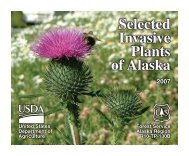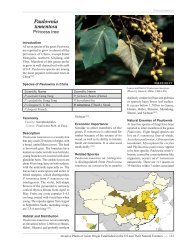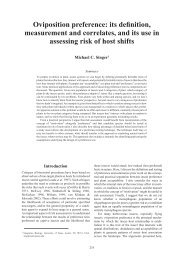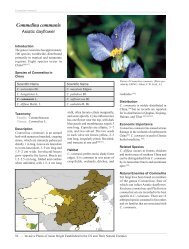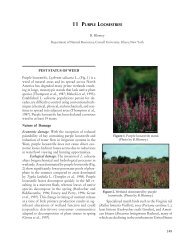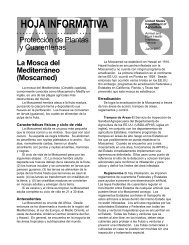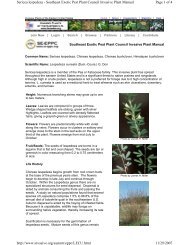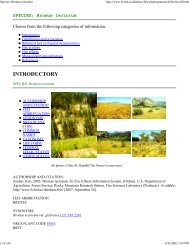A review of literature and field practices focused on ... - Invasive.org
A review of literature and field practices focused on ... - Invasive.org
A review of literature and field practices focused on ... - Invasive.org
You also want an ePaper? Increase the reach of your titles
YUMPU automatically turns print PDFs into web optimized ePapers that Google loves.
levels will work as well as the 5ml treatment with supplemental spray. L<str<strong>on</strong>g>and</str<strong>on</strong>g>scape trials<br />
comparing 3ml+foliar spray vs. 5ml+ foliar spray, however, found similarly positive<br />
results after 1 year <str<strong>on</strong>g>of</str<strong>on</strong>g> treatments.<br />
Because stem injecti<strong>on</strong> <str<strong>on</strong>g>of</str<strong>on</strong>g> knotweed requires a great deal more time <str<strong>on</strong>g>and</str<strong>on</strong>g> herbicide per<br />
treatment than foliar or integrated manual – foliar treatment, it may not be an appropriate<br />
choice for every knotweed occurrence. Injecti<strong>on</strong> does, however, save at least <strong>on</strong>e site<br />
visit, making it particularly attractive for treatment <str<strong>on</strong>g>of</str<strong>on</strong>g> remote sites. The <str<strong>on</strong>g>literature</str<strong>on</strong>g> suggests<br />
biologically active glyphosate herbicide should not move within the soil. However,<br />
because we have observed some limited instances <str<strong>on</strong>g>of</str<strong>on</strong>g> damaged native vegetati<strong>on</strong> (in the<br />
form <str<strong>on</strong>g>of</str<strong>on</strong>g> unusual growth patterns) within injecti<strong>on</strong> sites, because no data have been<br />
collected <strong>on</strong> levels <str<strong>on</strong>g>of</str<strong>on</strong>g> active glyphosate in the soil around injected patches, because the<br />
dose per patch level is quite high, <str<strong>on</strong>g>and</str<strong>on</strong>g> because many riparian habitat <str<strong>on</strong>g>of</str<strong>on</strong>g>ten include low<br />
levels <str<strong>on</strong>g>of</str<strong>on</strong>g> <strong>org</strong>anic soil materials or a high water table, c<strong>on</strong>cerns remain that glyphosate<br />
may move from roots or stems <str<strong>on</strong>g>of</str<strong>on</strong>g> injected plants <str<strong>on</strong>g>and</str<strong>on</strong>g> affect biota in the surrounding area.<br />
Comparis<strong>on</strong> <str<strong>on</strong>g>of</str<strong>on</strong>g> stem injecti<strong>on</strong> vs. foliar treatment…indicated that stem injecti<strong>on</strong> delivers<br />
approximately the same level <str<strong>on</strong>g>of</str<strong>on</strong>g> c<strong>on</strong>trol <strong>on</strong> a l<str<strong>on</strong>g>and</str<strong>on</strong>g>scape basis as foliar spraying, while<br />
requiring <strong>on</strong>e less <str<strong>on</strong>g>field</str<strong>on</strong>g> visit. Results from 2005 were somewhat better than those<br />
achieved previously, especially when patches treated for the first time were analyzed<br />
separately. Though still not close to the 90% <str<strong>on</strong>g>and</str<strong>on</strong>g> greater results gained in c<strong>on</strong>trolled<br />
experiments, the 83% average reducti<strong>on</strong> in stem number <strong>on</strong> a l<str<strong>on</strong>g>and</str<strong>on</strong>g>scape basis from a<br />
single treatment is substantially better than for previous treatment methods. However,<br />
given the additi<strong>on</strong>al time <str<strong>on</strong>g>and</str<strong>on</strong>g> relatively large volumes <str<strong>on</strong>g>of</str<strong>on</strong>g> herbicide required to perform<br />
stem injecti<strong>on</strong>, [it is recommended to] limit the use <str<strong>on</strong>g>of</str<strong>on</strong>g> stem injecti<strong>on</strong> to certain<br />
circumstances, specifically:<br />
• Remote sites<br />
• Patches encountered too late in the seas<strong>on</strong> for spring cut / fall spray treatment<br />
• L<str<strong>on</strong>g>and</str<strong>on</strong>g>owners who insist <strong>on</strong> injecti<strong>on</strong><br />
• Patches near sensitive or highly desirable vegetati<strong>on</strong> [see N<strong>on</strong>-Target Impacts<br />
secti<strong>on</strong> below]<br />
• Patches overhanging water [see N<strong>on</strong>-Target Impacts secti<strong>on</strong> below]<br />
• Patches with ~300 stems or less <str<strong>on</strong>g>and</str<strong>on</strong>g> a high percentage <str<strong>on</strong>g>of</str<strong>on</strong>g> injectable stems<br />
• Large patches with c<strong>on</strong>venient road access appear to be best treated with<br />
“traditi<strong>on</strong>al” methods.<br />
There are reports <str<strong>on</strong>g>of</str<strong>on</strong>g> n<strong>on</strong>-target symptomology <str<strong>on</strong>g>and</str<strong>on</strong>g> <strong>on</strong>e report <str<strong>on</strong>g>of</str<strong>on</strong>g> glyphosate in river water<br />
resulting from stem injecti<strong>on</strong> applicati<strong>on</strong>s, which are discussed in more detail below. It<br />
has been suggested that glyphosate may “leak-out” <str<strong>on</strong>g>of</str<strong>on</strong>g> knotweed roots/rhizomes <str<strong>on</strong>g>and</str<strong>on</strong>g><br />
remain active in coarser s<str<strong>on</strong>g>and</str<strong>on</strong>g>y <str<strong>on</strong>g>and</str<strong>on</strong>g> gravelly soils, which have relatively fewer herbicide<br />
absorpti<strong>on</strong> sites than soils with finer particles <str<strong>on</strong>g>and</str<strong>on</strong>g> <strong>org</strong>anic mater (Crockett, 2005; Oreg<strong>on</strong><br />
TNC, 2005a; Tim Miller, Extensi<strong>on</strong> Weed Specialist, Washingt<strong>on</strong> State University,<br />
pers<strong>on</strong>al communicati<strong>on</strong>). It would seem appropriate to c<strong>on</strong>sider this potential especially<br />
when working at sites with coarse soils <str<strong>on</strong>g>and</str<strong>on</strong>g> high water tables.<br />
Integrated approaches (IVM)<br />
20


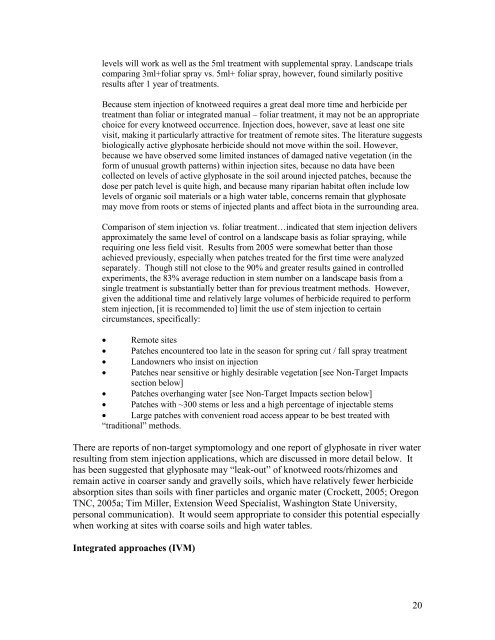

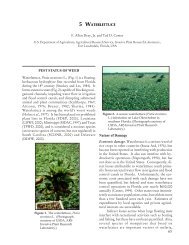

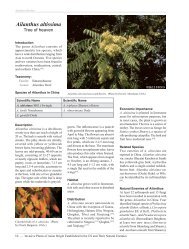
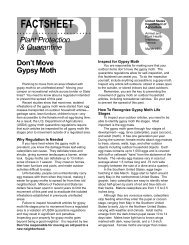
![A Guide to the Control and Management of Invasive Phragmites [PDF]](https://img.yumpu.com/27321025/1/190x190/a-guide-to-the-control-and-management-of-invasive-phragmites-pdf.jpg?quality=85)
